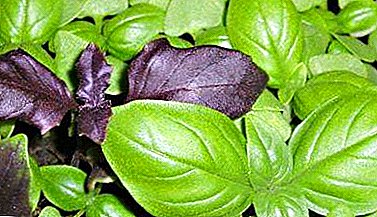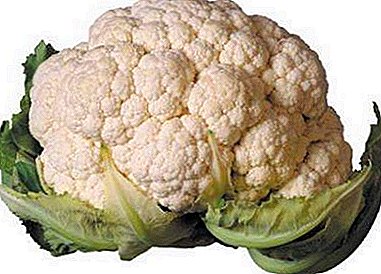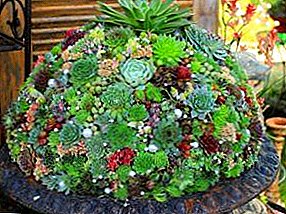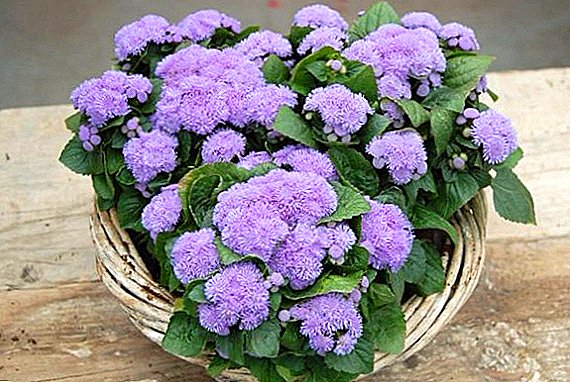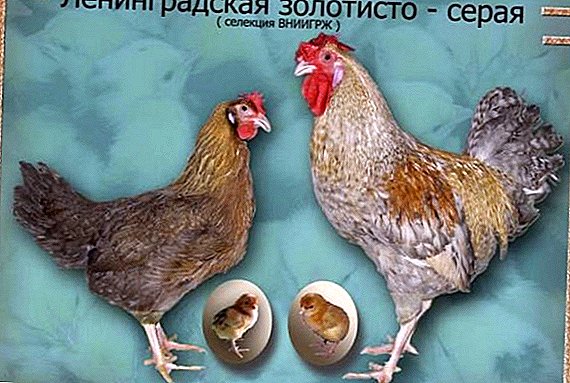 Leningrad chickens are considered a universal breed. Unpretentious to care, it will give a maximum of eggs and meat of good quality. Each owner must take into account the characteristics of the animal that will help get the maximum return in the economy. We will get to know the breed closer and learn about its pros and cons.
Leningrad chickens are considered a universal breed. Unpretentious to care, it will give a maximum of eggs and meat of good quality. Each owner must take into account the characteristics of the animal that will help get the maximum return in the economy. We will get to know the breed closer and learn about its pros and cons.
Inference history
This breed is the result of long-term experiments of breeders. Golden gray Leningrad first appeared in the 1970s. The ancestors of the birds - Striped and Brown Leghorn. It took 4 generations to manage to bring a universal chicken.
Important! Leningrad chickens have a good survival rate - for the young it is more than 90%, and for adults - more than 80%.After it began to appear and other species of the breed - White and Calico. Each has its own advantages - the representatives of White are large, and the Calico has a good exterior. But it was golden-gray that not only absorbed these qualities, but also gained new ones - a greater survival rate, high productivity.

Description
A relatively calm animal with an interesting color - you will not confuse it with anyone. A big plus is the rapid growth and weight gain, which allows you to get products much faster than from other breeds.
Check out the best meat and egg breeds of chickens.
Appearance and physique
The body of the Leningrad breed volumetric, regular shape. It has a gray color interspersed with golden feathers, which are getting closer to the head. The wings are closely pressed to the body, may also have a few golden feathers.
The skin under the feathers is light, has a yellowish tint.
The head is medium in size with a pink leafy comb and white and pink earrings. The legs are of medium size, the color is golden yellow. The tail is medium, well developed and has a dense plumage. 
Important! Already on the first day of the bird's life you can find out its gender - the chicken has dark stripes on the back and the cock - monochrome feathers.
Character
Representatives of this breed are calm and non-conflict. These qualities allow you to release for walking individuals of different ages and breeds.
Hatching instinct
This breed is a good fertilizer eggs - almost 80% fertilized. A plus is also the fact that the nestling instinct in chickens is preserved. In some individuals it may be mild, in others it is more. It depends on the conditions of detention, the number of chickens and roosters in the barn.
Productivity
The bred breed in its productivity surpasses many others. The average egg production for all breeds is 150, and for the golden-gray Leningrad, with a good diet, this figure is much higher. At the same time they begin to rush from 5 months. Initially, the eggs are not large, then they become larger and stronger.
Often in the winter chickens do not go well, but there are some simple tips that will help increase egg production even in winter. Also do not forget to use vitamins for laying hens.
 Chicken egg weight
Chicken egg weight
Live weight chicken and rooster
The body of animals is strong and weighty. The hen can weigh up to 2.5 kg, and the rooster can reach almost 4 kg. Extra cocks, which are sent to slaughter at a young age, without additional feeding and without giblets can weigh up to 2 kg.
Average annual egg production
Up to 200 eggs can be produced per year, each of which will weigh at least 60 g. There have been cases when an egg weighed under 90 g.
What to feed
For this breed, the same nutrition is suitable as for other chickens - high-quality compound feed, cereal, food waste and vegetables.
Learn how to cook compound feed for poultry.
Basic feeding tips:
- do not soak food, so that there is no food poisoning - it is better to give them in a dry form;
- in winter, add protein to the diet, such as fish oil;
- periodically supplement the diet with mineral supplements;
- in the summer, provide access to fresh grass; nettle will be especially useful;
- chickens should have free water.

Chickens
At first, prepare for brood a mixture of corn grits and ground eggs. Sour yogurt, cottage cheese, green onions are added on the third day of life.
For the cultivation of individuals older than 10 days, special, shredded mixed feed will be suitable. For growing chickens need vitamin complexes and supplements. If possible, provide access to live protein foods - worms, bugs, slugs.
We recommend to learn about common diseases of chickens and methods of their prevention.
It is important to add a little potassium permanganate to the drinking water of chickens every 5 days. This will help avoid infection. 
Adult chickens
In the summer, adults do not need a special diet, the main thing is to build an open-air cage in grassy and vegetative areas. Add premix in winter.
Scroll to the hen house and aviary place for the containers with shell or small gravel. This is necessary to ensure the grinding of food.
Conditions of detention
When creating housing for chicken brood, you need to consider that per individual requires at least half a square meter.
Coop Requirements
The coop must be spacious enough for the birds to move in it. The most important thing is to make it warm, without drafts, but with the possibility of airing. Also ensure daylight intake. Immediately you should think about artificial lighting - in the winter it will help to increase the daylight hours.
Did you know? Only one chicken can grow in one shell, there will not be enough space for two of them. Therefore, eggs with two yolks never give double offspring.
 For every 4 individuals, you need to make a nest of no more than 50 by 50 cm. To do this, you can take a box for products.
For every 4 individuals, you need to make a nest of no more than 50 by 50 cm. To do this, you can take a box for products.
Place them at a height of 70 cm from the ground, and even higher by 20 cm organize roosts. If the birds ignore the nests, try moving them to another location.
It is better not to keep Leningrad chickens constantly in cages, this will adversely affect the number of eggs laid. Inside there should be containers with sand and wood ash, so that birds can clean their feathers from insects.
Get acquainted with the peculiarities of chickens in the cages.
For this breed are suitable ordinary chicken coops with earth mound on the floor. Also on top of the floor sprinkled with hay to make it easier to clean the area. Clean the litter every 2 months. Also, a general cleaning is done once a year with the territory treated with antiseptics. Practicing the treatment of the chicken coop with boiling water or steam - it helps to kill more germs.
Walking yard
In the warm season, chickens must have a walking cage. There are no special requirements for its size, but the more the better. Take care that the birds are not able to fly the fence. To do this, make it at least 1.5 m tall. The courtyard must also be cleaned every 2 months. 
Feeders and drinkers
Feeding equipment can be purchased or made by yourself. For example, drinking bowls are made from buckets, plastic bottles. The main thing is that the birds have constant access to clean and fresh water.
Feeders should be:
- large to contain a double portion of dry feed;
- for dry products only wood, and wet products - plastic or metal;
- Chickens should have constant and easy access to them;
- You can weight plastic feeders made of plastic with wooden beams so that the birds do not turn them over.
Learn how to make a feeder and drinker for chickens with your own hands.

How to endure winter cold
In chicken coops, the Leningrad breed normally tolerates winter cold. If possible, try to warm the room - it will increase egg production.
Advantages and disadvantages
The breed has such advantages:
- high productivity;
- rapid growth and weight gain;
- calm character;
- high survival rate;
- adaptability to any conditions;
- unpretentious care;
- disease resistance.
- a weakly expressed instinct of incubation in some individuals (for those who plan to receive eggs for food and sale, this will be a plus).
Did you know? For the first time a chicken was made a pet about 3 thousand years ago in Ethiopia.

So, the Leningrad golden-gray breed has many more advantages than disadvantages. This is due to the universality of the bird. In addition, for those who aim to make a profit from the sale of products from these chickens, it will be easier to get more earnings. With a good diet, these chickens can quickly gain weight and produce more eggs.
Reviews



